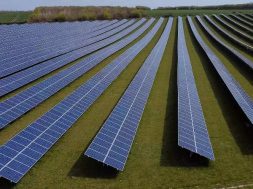
Nanoscale Coating Developed by US Research Team Boosts Light Absorption and Current of Solar Cells by 20%
The US National Institute of Standards and Technology (NIST) has just announced the development of a low-cost nanoscale coating that can increase the sunlight absorption of solar cells by around 20%.
This innovation has the potential to enter the growing portfolio of technologies that solar photovoltaics companies can access to make products that are more economical, efficient and environmentally friendly.
The concept of a whispering gallery serves as the basis for the design of the nanoscale coating. According to the concept, sound and light waves can travel around a curved, bowl-shaped surface, such as the surface under a dome structure. Therefore, a person standing close to the wall of a dome structure can hear sounds coming from the other side of the dome, even if the sounds originate faraway and are fairly faint. The whispering gallery concept was first discovered under the dome of St. Paul’s Cathedral in the UK capital London.
Based on the same idea, a research team in the US has created a coating composed of thousands of tiny glass beads with diameters that are roughly one-hundredth of the width of a human hair. As the sunlight reaches the coating, the light waves will move around the curved surfaces of the glass beads. This in turn boosts the capture of visible sunlight.
Other researchers already applied the whispering gallery concept to experiments involving light and optics about a decade ago. However, the instances of the concept being applied in the development of solar energy solutions are few. The latest nanoscale coating was created by a team composed of researchers from NIST and Maryland NanoCenter at the University of Maryland in the US. The material, which is also called the nanoresonator coating, is porous as to allow the light to penetrate and contact the underlying solar cell that is made of gallium arsenide.
The image below shows nanoscale glass beads of various diameters (as indicated by different colors). Each of these beads can act as an optical whispering gallery or resonator for specific wavelengths of the sunlight. The NIST-NanoCenter team used a laser to test the nanoresnators in the coating and discovered that the light absorption of the coated cells was 20% greater on average compared with the cells that did not receive the coating. The coated cells also produced 20% more current.
Dongheon Ha, a postdoctoral researcher who is with the team, said that this study is the first of its kind in using precision nanoscale measurement technologies to find out the efficiency of the coating. Ha added that the in-house measurement technologies were instrumental in proving their earlier calculations and the effectiveness of the material in raising cell efficiency.
In addition, the NIST-NanoCenter team has developed a rapid and inexpensive rod method for applying the coating on the solar cells. According to the team’s method, droplets of the nanoresonator solution are placed on one side of the solar cell, and then a wire-wound metal rod is pulled across the cell’s surface, thereby spreading out the solution as to create a layer of tightly packed nanoresonators. Previously, the solar cell had to be totally immersed in the nanoresonator solution, thus taking more time to treat both sides of the cell even though only one side should be coated. Ha pointed out that this was the first time that researchers used the rod method to apply the nanoresonator coating on the solar cells. Ha also stated that the process is not only economical but also suitable for mass production as well.
The study of the nanoresonator coating is published in the journal Nanotechnology on 15 February 2018.
(The above article is an English translation of a Chinese article written by Daisy Chuang. The image in the article is an artist’s rendition of the glass beads that make up the nanoresonator coating. Its credit goes to the National Institute of Standards and Technology.)














